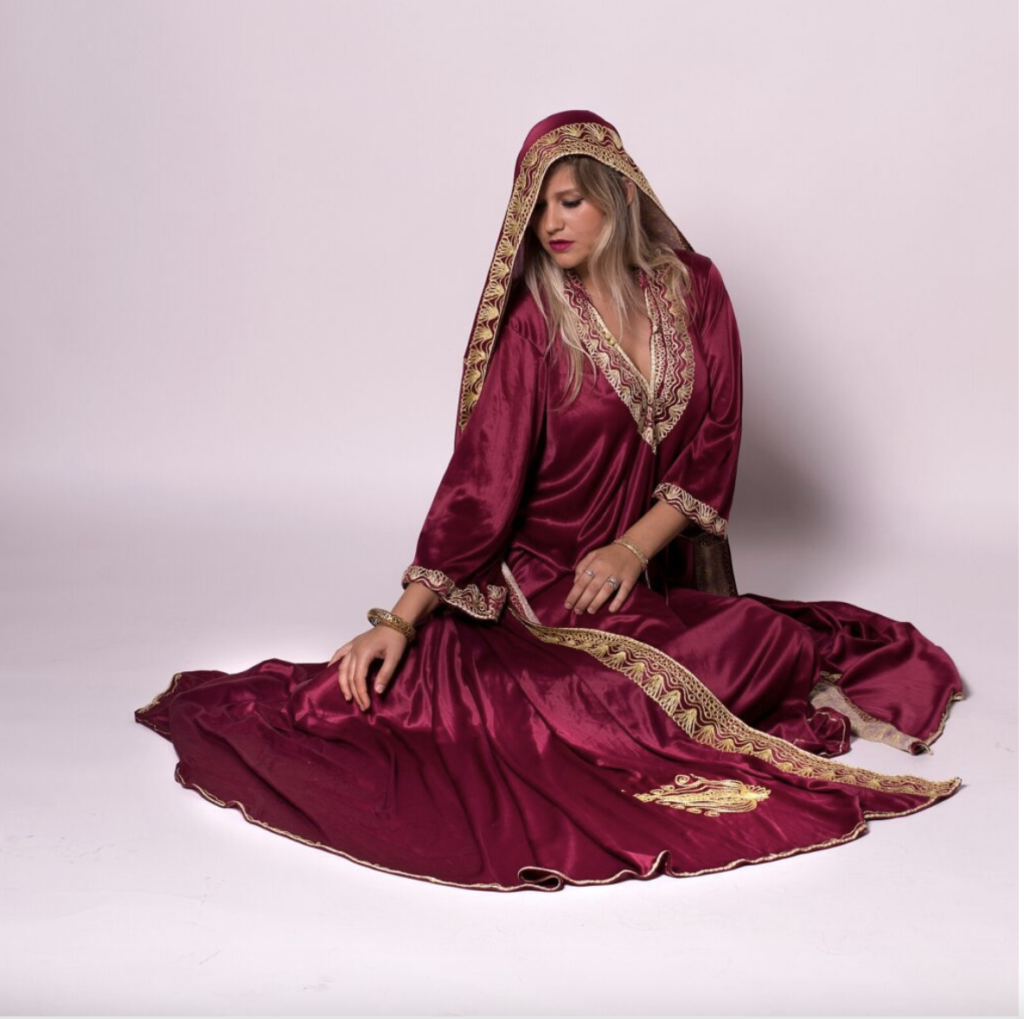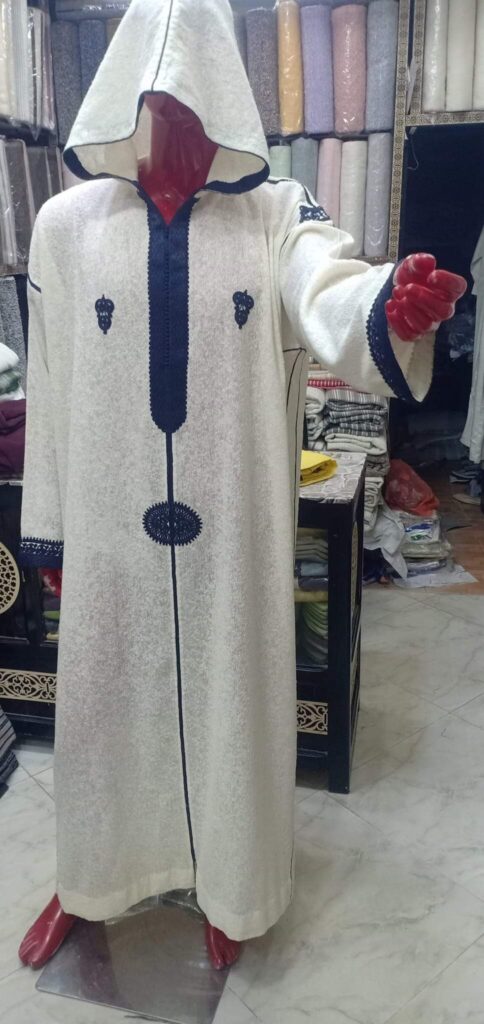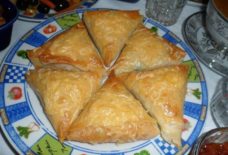Moroccan Fashion: A Timeless Blend of Tradition and Modern Trends

By: Arab America Contributing Writer Rania Basria
Morocco, a country rich in history and cultural variety, has long been a crossroads between civilizations. This unusual position has had a significant impact on art, architecture, food, and, most importantly, fashion. Moroccan fashion is a fascinating patchwork of heritage and modernity, with centuries-old clothes such as kaftans and djellabas coexisting alongside contemporary styles inspired by worldwide trends. Arab America contributing writer, Rania Basria, delves into the rich world of Moroccan design, from traditional to modern trends that are defining the country’s present fashion environment.
Morocco’s traditional dress reflects not only its culture, but also its climate, geography, and social norms. The following clothes are essential pieces of Moroccan dress, reflecting both the ordinary and the ceremonial.
The kaftan is arguably the most iconic item of Moroccan attire. It is a long, flowing robe often worn by ladies, distinguished by sumptuous materials, elaborate embroidery, and a casual yet royal style. The kaftan originated in the Middle East and North Africa, where it was worn by men and women. In Morocco, however, the kaftan has developed into a distinctly feminine gown.
Historically, the aristocracy wore kaftans, particularly on important occasions like weddings, religious holidays, and formal ceremonies. The style of the garment would frequently represent the wearer’s social rank, with wealthier people wearing kaftans made of silk, brocade, or velvet embroidered with gold or silver thread. Traditional Moroccan kaftans are also known for their hand-embroidered designs, which frequently incorporate motifs influenced by nature, Islamic geometry, and local handicraft.
The kaftan is a symbol of elegance today, and it is widely worn at weddings and other important occasions. Moroccan designers have given this traditional clothing new vitality by mixing modern styles with traditional workmanship. Modern kaftans can have inventive cuts, brilliant colors, and a mix of modern and traditional textiles, making them a staple in Moroccan fashion.

The djellaba is another key piece of Moroccan apparel that is worn by both men and women. It’s a long, loose-fitting robe with a pointed hood called a “qob,” which protects against the sun and wind. The djellaba, made of lightweight cotton or wool, is suitable for Morocco’s varied environment, which ranges from the frigid Atlas Mountains to the sweltering desert.
Women frequently wear the djellaba over their ordinary attire, although males customarily wear it for both formal and casual situations. The djellaba, like the kaftan, can be modest or extravagant according to the occasion. Women’s djellabas are frequently embellished with embroidery and available in a range of hues, whilst men’s djellabas are more muted in tones such as beige, white, and brown.
Because of its versatility, the djellaba has stood the test of time. It is strongly ingrained in Moroccan society, even as current fashion trends shift.
No study of traditional Moroccan clothes would be complete without including the distinctive tarbouche (also known as the fez) and babouche. Men customarily wear the tarbouche, a brimless, flat-topped hat that is generally crimson with a black tassel. It has become a symbol of Moroccan identity and is still worn at formal events.
Babouches, or traditional Moroccan slippers, are another necessary item. Both men and women wear these leather shoes, which are sometimes vividly colored and have pointy toes. Babouches are primarily handcrafted and available in a wide range of styles, from plain and functional to intricate and ornamental. Babouches are now renowned as a fashionable and comfortable footwear option among both locals and foreign fashion fans.
While traditional Moroccan attire remains a part of the country’s fashion identity, there is a rising preference for more modern styles that combine Moroccan heritage with current trends. This blend of old and modern is resulting in a vibrant fashion environment in which both designers and customers are reinterpreting traditional clothing in novel ways.
Several Moroccan designers have achieved worldwide success by combining the country’s rich cultural history with modern design approaches. These designers frequently draw influence from the past, adding traditional aspects like as embroidery, beaded, and Moroccan textiles into their creations while also looking at global fashion trends.
For example, acclaimed designer Fadila El Gadi is well-known for her beautiful craftsmanship, particularly her use of Moroccan embroidery. She has adapted ancient techniques passed down through generations to new shapes, resulting in apparel that seems both timeless and fresh.
Similarly, Maison Artc has pioneered modern Moroccan fashion by combining avant-garde designs with traditional Moroccan elements. His collections frequently include bold, experimental designs and a variety of textures, providing a contemporary interpretation of Moroccan identity.
Moroccan streetwear has recently arisen as a key style, reflecting the country’s young, urban population and its involvement in global fashion movements. Morocco’s streetwear mixes traditional Moroccan clothes with the laid-back, informal attitude popularized by Western design.
For example, it is not uncommon to see young Moroccans dressed in djellaba-inspired hoodies, kaftan-style gowns, or babouches with jeans. This fusion of the ancient and contemporary is most visible in towns like Casablanca and Marrakech, where fashion-conscious youngsters are reinventing what it means to be Moroccan.
Moroccan streetwear labels like Amine Bendriouich and Zyne Studios are receiving global attention for their creative designs. These businesses are pushing the frontiers of Moroccan design, creating apparel that seems modern while remaining true to the country’s cultural past.
Rihanna, Beyoncé, and Naomi Campbell have been spotted wearing Moroccan-inspired designs, cementing the country’s influence on the global fashion stage. International designers such as Yves Saint Laurent have long been inspired by Moroccan culture, and the fashion house continues to draw on Moroccan motifs and fabrics in its collections today.
Marrakech, in particular, has become a hotspot for fashion travel and inspiration. With its colorful souks, breathtaking architecture, and rich history, the city draws designers, influencers, and fashion enthusiasts from all over the world. The annual Caftan Show in Marrakech, which features both traditional and modern kaftan designs, is an important event on the worldwide fashion calendar.
Morocco’s fashion sector is embracing more environmentally friendly practices as sustainability emerges as a major concern. Because they use artisanal methods that have been handed down through the years, traditional Moroccan handicraft like handweaving, embroidery, and natural dyeing is by its very nature sustainable.
A growing number of Moroccan designers are increasingly stressing the value of slow fashion and creating well-made, long-lasting clothing. This strategy is in contrast to the quick fashion sector, which is frequently linked to unethical labor methods and environmental destruction.
Moroccan fashion offers a more sustainable option to mass-produced apparel while also conserving the country’s cultural legacy through the promotion of traditional handicraft and the support of regional artisans.
Moroccan fashion is a mesmerizing fusion of history and contemporary style, with iconic pieces like the djellaba and kaftan inspiring designers worldwide. Although the fashion industry in the nation is strongly influenced by its cultural past, it is also changing and embracing modern looks and environmentally friendly methods. Moroccan streetwear, from its innovative modern designs to its exquisite hand-embroidered kaftans, never fails to enthrall and inspire on the international scene.
Visit Arab America’s blog here!








